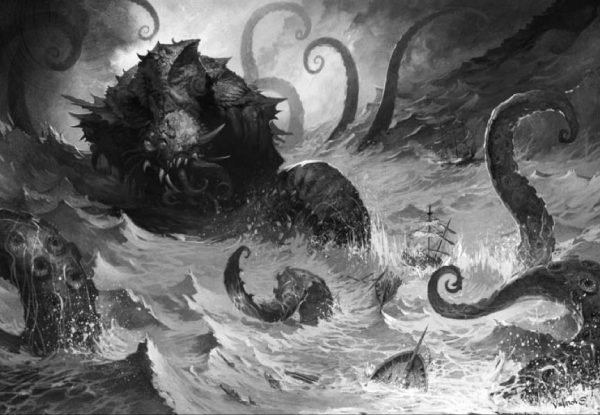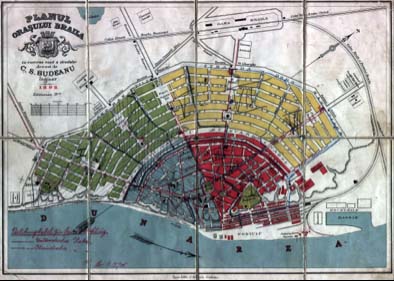The following notes accompany the August 3, 2019 CONTRASTS concert.
Kraken (2012)
Du Yun (b. 1977)
West Coast Premiere
 In 2009, I began to use a series of titles that are based on fables from mythology.
In 2009, I began to use a series of titles that are based on fables from mythology.
A kraken is a sea dragon or sea serpent that might have a hump a mile and a half long and arms that can encircle the largest ship. These half-gods half-demons are at once familiar and foreign, figures alive across many cultures, latitudes, and ages. This sensibility is very close to me at heart: it speaks the belief I endure, the lives we live often land on the edge of the in-between-ness.
We don’t know what a kraken is. And yet we could often see ourselves in these mythological figures. As if a memory from past of the future, future of the past. We are able to recognize all these elements in ourselves.
Kraken is non-narrative, non-programmatic; I borrowed the idea for its intangible spirit. Instead of movements, the piece incorporates three chapters. The idea is appropriated from the structure of some novels, where parallel narratives can be developed in consecutive chapters, rather than a linear thematic development. To witness a figure that mutates over time and to see how the matter detangles, unfolds, and dissipates.
—Dun Yun
DANCE for cello and orchestra (2019)
Anna Clyne (b. 1980)
West Coast Premiere | Festival Co-commission
The composer has provided the following note:
DANCE is dedicated with much love to my father, Leslie Clyne.
Dance, when you’re broken open.
Dance, if you’ve torn the bandage off.
Dance in the middle of the fighting.
Dance in your blood.
Dance, when you’re perfectly free.
—Rumi
The Work at Hand (2015)
Jake Heggie (b. 1961)
Text by Laura Morefield
West Coast Premiere
The late Laura Morefield (1960–2011) was a private poet, unknown to most people. Her mother, the gifted San Diego poet and writer Charlene Baldridge, has been a friend for nearly 20 years, and I’ve set several of her poems. Laura was the friendly, bright-eyed, soft-spoken powerhouse I knew primarily as Charlene’s daughter, who I would sometimes see when they traveled on their annual mother-daughter adventures: a couple of times to a premiere of mine, then on a cruise through the Baltic when Frederica von Stade and I gave recitals as the entertainment. Laura was immensely proud of her mother’s poetry, but was fairly quiet about her own work. Shortly after the Baltic cruise in 2008, Laura was diagnosed with advanced colon cancer. That’s when I found out about her poetry and asked if she would send me several, including her top 10 favorites. Shortly after, a packet of shatteringly beautiful poems arrived with The Work at Hand on top. I was completely overwhelmed and asked if I could set this poem one day. She was delighted. Not long after that—but after an extraordinarily brave fight—Laura passed away. None of us could believe it. She was 50 years old.
The Work at Hand is one of Laura’s post-diagnosis poems. It is about the difficult and deeply human experience of knowing it is time to say goodbye and let go: resenting, fighting, struggling, and then finding peace in acceptance. The language and imagery she chose is particularly striking: origami, the yoga Warrior 1 position, and a shimmering reconnection to nature.
The opportunity to set The Work at Hand presented itself when Jamie Barton asked for a new set of songs for her Carnegie Hall recital, and Anne Martindale Williams asked for a new piece to perform with the Pittsburgh Symphony Orchestra, where she is principal cellist. Being a little too busy these days (and counting my blessings for that), I suggested we combine it into a piece that exists as a chamber and an orchestral work. Both agreed. The premiere of the chamber version took place at Carnegie Hall on Feb 17, 2015 with pianist Bradley Moore. The orchestral version received its premiere May 15, 2015 in Pittsburgh at Heinz Hall, conducted by Michael Francis.
Laura’s final request to her mother was that she publish a collection of her post-diagnosis poems in a chapbook, and that exists as The Warrior’s Stance. All proceeds from sales of the book benefit the Colon Cancer Alliance (thewarriorsstance.com). I’m deeply grateful to Laura’s amazing husband Dan Morefield for his generosity in granting me permission to set The Work at Hand; to Charlene for her passion, friendship, and guidance; and to Jamie and Anne for saying yes to the journey.
—Jake Heggie
THE WORK AT HAND
By Laura Morefield
Some moments:
I feel compelled to start my long goodbye – folding advice
until it reveals hope, creasing resilience side by side with laughter
tucking courage into the pocket made by joy – making
the message of my life into individual origami.
I want to start this project early because
there are so many
(nieces, nephews, brothers, sisters, parents,
friends) who enfold my life with grace and song.
(And then there is also and always you.)
Other times:
The work of goodbye seems a betrayal,
a prediction of defeat – inappropriate to my
interior pose of being.
A warrior keeps her back leg strong, connected
to the earth. She faces her hips forward.
She lifts hands and face skyward as
her front leg leans into the territory of the enemy
as far as, as long as, her breath will take her.
And then:
there are slow seconds like these,
when the single square of window reveals
pine tree needles bursting into branches,
making their stubborn way through a furrowed trunk.
When the wind moves
like a feathered thing over my waiting skin.
When all I want is to unfold a small quilt
of sunlight onto the cool green and sit very still,
to let the light of heaven flow over me like honey
until my bones are on fire with the beauty of it all.
Levante for Orchestra (2018)
Dan Dediu (b. 1967)
U.S. Premiere
 Chimeric mind map of the generic East, as in Schumann’s Bilder aus Osten? Central point of a spiritual geometry, as in Kagel’s Stücke der Windrose? Homage to the distance, as in the Ligeti’s Lontano? All three, certainly, and more: a symbolic auditive mandala, retrograde form (the bridge-form ABCDCBA/coda); a melodic main motif, built from three intervals: a minor second and two minor thirds; a musical transposition of the street architecture of my (and Xenakis’) hometown of Brăila, where all the streets form concentric semicircles (beginning and ending on the Danube) around a central axis, shaped like a Menorah.
Chimeric mind map of the generic East, as in Schumann’s Bilder aus Osten? Central point of a spiritual geometry, as in Kagel’s Stücke der Windrose? Homage to the distance, as in the Ligeti’s Lontano? All three, certainly, and more: a symbolic auditive mandala, retrograde form (the bridge-form ABCDCBA/coda); a melodic main motif, built from three intervals: a minor second and two minor thirds; a musical transposition of the street architecture of my (and Xenakis’) hometown of Brăila, where all the streets form concentric semicircles (beginning and ending on the Danube) around a central axis, shaped like a Menorah.
What one expects from a generic East? Among others, emotional intensity and extreme contrasts. Side effects: monstrosity, cruelty, madness, consolation, compassion, ecstasy. Levante.
—Dan Dediu
